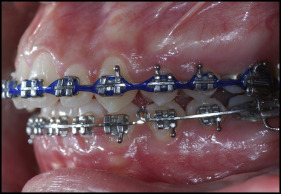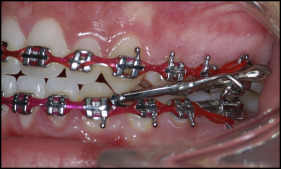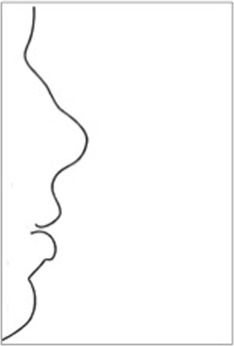Introduction
In this retrospective study, we aimed to evaluate the effects on the facial silhouettes produced by a mandibular protraction appliance associated with corrective treatment in Class II patients.
Methods
The sample consisted of 54 (27 initial and 27 final) lateral radiographs from 27 patients. Of these patients, 14 were girls and 13 were boys, with a mean initial age of 12.27 years and a mean treatment period of 2.9 years. An album containing the silhouettes of the pretreatment and posttreatment profiles based on the lateral cephalograms of the patients was prepared. Then, 60 orthodontists and 60 laypeople chose the more esthetic facial silhouette (A or B) and the amount of alterations they perceived between the 2 silhouettes, according to a visual analog scale. A paired t test was used to compare the 2 groups of evaluators with a 5% significance level.
Results
Differences between the preferences regarding the pretreatment and posttreatment facial silhouettes were statistically significant for both groups. The posttreatment silhouettes were preferred by most evaluators. The visual analog scale scores showed that the lay evaluators identified greater differences between the pretreatment and posttreatment silhouettes than did the orthodontists ( P <0.001).
Conclusions
Based on the evaluators’ judgments, treatment with the mandibular protraction appliance had a positive effect on the facial silhouette, and the laypeople better perceived this effect.
Highlights
- •
Patients were treated with the mandibular protraction appliance plus orthodontics.
- •
Facial profile silhouettes were rated by orthodontists and laypersons.
- •
Both groups preferred the posttreatment profiles over pretreatment.
- •
Preferences for posttreatment profiles were stronger among orthodontists.
- •
Laypeople reported greater improvement than did orthodontists.
Orthodontists have studied the soft tissue profiles of patients for many years to establish a precise diagnosis and individualized treatment plan for obtaining correct tooth positioning and facial harmony.
Class II malocclusion accounts for 42% of malocclusion cases, of which 15% have skeletal involvement and 27% affect only the dentoalveolar region, with a good relationship between bone bases. However, this malocclusion may compromise facial esthetics in various degrees, according to the magnitude of overjet and its relationship to soft tissues; these affect patients’ self-esteem and quality of life.
Many designs of fixed appliances have been introduced for the treatment of Class II malocclusions with mandibular retrognathism by promoting a postural change of the jaw, positioning it forward stimulate its growth. According to idealizers, each unit promotes specific dental and skeletal alterations, and the manufacturing processes and applications are quite varied. The choice of the ideal mechanism depends on the knowledge or preference of the professional, or even the patient’s cooperation.
Today, the growing demand for esthetic results has led orthodontists to prioritize patients’ opinions to set a treatment plan that meets their needs. However, beauty standards are highly subjective. They are influenced by the cultural characteristics of a population and the areas where patients live. Over the years, facial esthetic standards have undergone significant changes; therefore, orthodontists must be acquainted with what the population currently considers an ideal face.
The opinions of laypeople and dentists about the facial changes caused by Class II treatment with removable functional appliances and with extraction of the maxillary 2 first premolars were investigated, and no significant changes in the facial profiles were found. Because of the high incidence of Class II malocclusions, orthodontists must have excellent judgment in planning this malocclusion treatment, paying attention to esthetic and functional needs. The planning option will depend on the professional’s preference and skill, in addition to scientific evidence, clinical aspects, and patient compliance, which need to be considered. Thus, an orthodontic treatment plan should not be based solely on satisfactory occlusal outcomes or on isolated or cephalometric numbers, but its effect on facial esthetics should be considered as well. In view of these considerations, our aim in this study was to evaluate the esthetic effects of a mandibular protraction appliance (MPA) from the perspectives of orthodontists and laypeople.
Material and methods
The research ethics committee of Sagrado Coração University, Bauru, São Paulo, Brazil, approved this study under protocol number 1.119.794. The study sample consisted of 27 patients who were treated with fixed braces ( Fig 1 ) combined with an MPA for a mean period of 2.9 years (34.8 months). Of the subjects, 14 (51.9%) were girls, and 13 (48.1%) were boys, with mean initial and final ages of 12.27 and 15.10 years. At the beginning of treatment, the patients had Angle Class II Division 1 malocclusions bilaterally, no agenesis or loss of permanent teeth, no supernumerary or impacted teeth, no tooth size or shape anomalies, no inferior or minimal crowding, a convex facial profile, and increased overjet (minimum, 6 mm).

All patients were treated with an MPA for 7 months ( Fig 2 ), until achieving a Class I molar relationship and a reduction of overjet. After the braces were removed, retainers were installed in the maxillary and inferior arches.

An album containing the silhouettes of the pretreatment and posttreatment profiles based on the patients’ lateral cephalograms was randomly prepared. Tracings were performed by 1 researcher (D.F.S.) in a dark room for easy identification of anatomic structures. The soft tissue profile design was made by using a 0.5-mm graphite pencil on acetate paper, 0.07 mm in thickness and 17.5 mm in width and length, adapted to the radiographs ( Fig 3 ).

The tracings were scanned and transferred to the computer, and filling of the soft tissue profile was performed by 1 computer technician by using the Adobe PhotoShop software (Adobe Systems, San Jose, Calif). The 2 (pretreatment and posttreatment) silhouettes for each patient were placed randomly on the same sheet ( Fig 4 ), rather than positioning the pretreatment silhouette on either the right or left side of the sheet to create an album with all silhouettes of the patients.
Two groups of evaluators participated in the survey to judge the facial silhouettes of each patient. The evaluators were divided into 2 groups. The orthodontists group consisted of 60 specialists in orthodontics, of whom 31 (51.7%) were women and 29 (48.3%) were men, with a mean age of 35 years 5 months. The other group (laypeople) consisted of 60 people with no orthodontic knowledge classified as laypeople. In this group, 25 (15%) were men and 45 (75%) were women, with a mean age of 35 years 3 months.
Each evaluator received an album containing the silhouettes of the patients, an attachment with instructions on how to fill out the answers, and an evaluation sheet. The evaluators were asked to indicate their preferences with respect to the silhouettes (A or B) and the amount of the difference perceived between the 2 silhouettes according to a visual analog scale (VAS). The VAS was defined as a 100-mm line, where zero at the leftmost end indicated that the silhouettes were identical, and the opposite end, on the right, indicated that the silhouettes were very different. Thus, the evaluators marked a vertical stripe between the left and right ends of the line to indicate their scores.
Statistical analyses
Data were described by using mean and standard deviation parameters. To verify whether the data had a normal distribution, the Kolmogorov-Smirnov test was used, and no measurement showed a statistically significant deviation from normality. For comparison between the 2 groups and between women and men, we used the paired t test and adopted a significance level of 5% ( P <0.05).
To determine the method error, the evaluations were repeated with 30% of the evaluators in each group (orthodontists and laypeople). To assess the preference between the pretreatment and posttreatment silhouettes, the kappa coefficient was used to assess intraexaminer agreement, and the classification proposed by Landis and Koch was used to interpret the results. The result indicated satisfactory agreement between the laypeople’s (kappa, 0.39) and the orthodontists’ (kappa, 0.37) evaluations.
To verify the agreement in VAS scores, the intraclass correlation coefficient was performed, and the values suggested by Fleiss were applied for the interpretation of the results. These values were 0.53 (satisfactory) for the laypeople and 0.57 (satisfactory) for the orthodontists.
All statistical procedures were conducted by using the Statistica software (version 5.1; StatSoft, Tulsa, Okla).
Considering the percentage of preference for either silhouette (pretreatment or posttreatment), based on the results obtained (with a standard deviation of the difference between laypeople and orthodontists of 8.3%) for a significance level of 5% ( P <0.05), the sample size of 27 subjects showed 86% power to detect a minimum difference of 5% in the preferences between the laypeople and the orthodontists.
With regard to the VAS scores based on the results obtained (with a standard deviation of the difference between laypeople and orthodontists of 7.3 mm), for a significance level of 5% ( P <0.05), the sample size of 27 subjects showed 93% power to detect a minimum difference of 5 mm between the laypeople and the orthodontists.
Results
The results showed that both groups of evaluators preferred, in a remarkably greater number, the postorthodontic treatment silhouettes ( Table I ). In the laypeople group, 22.3% preferred the pretreatment silhouettes, and 77.7% preferred the posttreatment silhouettes. The findings were similar for the orthodontist group: 14.4% preferred the pretreatment silhouettes, and 85.6% preferred the posttreatment silhouettes ( Table I ).
Between the pretreatment and posttreatment silhouettes (A and B), the difference identified by the group of lay evaluators was greater than that of the orthodontists ( Table II ).
| Measurement | Laypeople | Orthodontists | P | ||
|---|---|---|---|---|---|
| Mean | SD | Mean | SD | ||
| Preference for posttreatment (%) | 77.7 | 16.9 | 85.6 | 16.8 | <0.001 ∗ |
| Quantification of the difference when the pretreatment profile was preferred (VAS) | 63.2 | 13.3 | 54.6 | 16.7 | 0.022 ∗ |
| Quantification of the difference when the posttreatment profile was preferred (VAS) | 65.8 | 11.9 | 61.8 | 11.7 | 0.008 ∗ |
Stay updated, free dental videos. Join our Telegram channel

VIDEdental - Online dental courses


